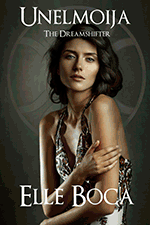Luxury Travel Review

Eighteenth century home museum near Paris worth visit when in Seine-et-Marne area
By Elena del Valle
Photos by Gary Cox

Champs-sur-Marnes on a cloudy rainy day
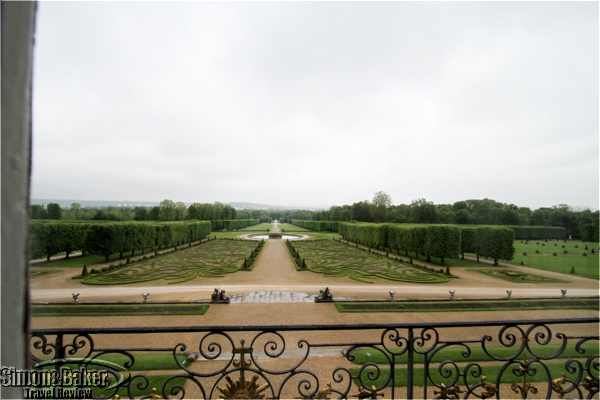
A view of the Notable Gardens, inspired by Le Notre’s work, from the second floor
We liked visiting the Château de Champs-sur-Marne (31 rue de Paris 77420 Champs-sur-Marne +33160052443. www.chateau-champs-sur-marne.fr, champs@monuments-nationaux.fr) in the Seine-et-Marne Department (www.turisme77.co.uk and www.paris-whatelse.com) in the town of Champs-sur-Marne near Paris, France. A private home in the eighteenth century the property was completed in 1708. It was managed by the Centre des Monuments Nationaux, a government entity. Champs-sur-Marne is within an 85 hectare estate in the town of the same name, about 25 minutes from Paris by public transportation (RER A) and a 30 minute drive via highway A4.

The furniture in the entry hall
The 16 room two story structure stood out for its rococo style and its Notable Gardens, inspired by Le Notre’s work and restored in 1895. Because of rainy and cold weather we missed visiting the gardens. In its heyday the Castle of Champs-sur-Marne welcomed illustrious tenants such as the princess of Conti, duke de La Vallière, and la Marquise de Pompadour. In 1895, Louis Cahen d’Anvers, a banker, bought and restored the property, and in 1935, the Cahen d’Anvers family donated the property to the state. About 1,800 square meters of the 3,600 square meter large property were open to visitors, including the second floor and basement.

Asian style decor was popular despite a lack of accurate information about the subject matter.

A glass covered close up where the removal of paint revealed further paintings underneath
During our visit to the Seine-et-Marne the Château de Champs-sur-Marne served as a contrast to other larger and far more pompous properties such as the Chateau de Fontainebleau, the former royal homestead, and Vaux-le-Vicomte, the famous precursor to Versailles. Like Vaux-le-Vicomte, Champs-sur-Marne served as a model for another well known property, the Elysee Palace in Paris completed in 1720. The north facade’s special feature, the rotunda, is similar to the one at the Hôtel de Matignon, the official residence of the first minister.

One of the rooms appeared inviting
The Château de Champs-sur-Marne was built as the home of a newly wealthy family wishing to impress society, whereas the other two area properties were designed for the public as well as private life of their affluent residents. A staff of 37 looked after the property. In 1959, President Charles de Gaulle began using it as an official residence for government guests. In 1974, the Ministry of Culture took over management of estate, allowing the public to visit the castle and its grounds. In 2006, parts of the Chinese Salon ceiling collapsed, requiring a six year long restoration. Although it was reopened in 2013 it looked like it could use additional work.

The rooms were decorated according to purpose with light colors for women or mixed groups.
If the Château de Champs-sur-Marne looked familiar, our English speaking guide explained, it was because a number of films were shot on the estate, including Dangerous Liaisons (1987) by Stephen Frears, Ridicule (1995) by Patrice Leconte, and Marie-Antoinette (2005) by Sofia Coppola.The orangery of the castle also appeared in the series Versailles (2016) by Jalil Lespert.

The dark rooms were offices and places for men to gather.

The billiards room
Our guide especially noted the chinoiseries painted decorations and the door panel (in the Cabinet Camaïeu) by Christophe Huet, among the highlights of the era. Other noteworthy features included, in the great hall, the Coromandel screen from the 18th century restored in 2016; faience pieces from the 18th century in various rooms as well as exceptional pendulums, for example, the pendulum Tête de Poupée by Jacques Auguste Thuret, clockmaker to the King Louis XIV in 1694 in La Chambre Grise; and “le Bonheur-du-jour” signed Charles Topino in the 18th century, a desk for the ladies.
Florida beach house’s outstanding location offset by issues

Limefish from the beach
Although we loved our Holmes Beach rental house’s beachfront location, its outstanding views of the water across lush sea oats and sea grapes from the open porch as well as from the single contiguous air conditioned living, dining and kitchen room, we were disappointed with a number of aspects of the luxury rental house. Holmes Beach is one of three municipalities on Anna Maria Island on the west coast of Florida. In addition to its outstanding beachfront place the house was on the north end of Holmes Beach, which after some exploration became our favorite part of the island along with the town of Anna Maria. It was also conveniently one block away from a complimentary island trolley stop, and within walking distance to the main shopping streets in the town of Anna Maria.

The living room featured an outstanding view of the beach
Limefish, a 1,500 square foot colorful three bedroom three bathroom house, faced the beach. The pool was on the north side and included a shady covered open air area with a propane grill, two lounge chairs, outdoor dining furniture with seating for eight and two showers. Indoors the air conditioned house was painted in bright colors. It had a master bedroom with a king bed and small en suite bathroom, a second bedroom with a queen bed and standard en suite bathroom, and a third bedroom with four bunk beds and an adjacent bathroom convenient for guests. The living area had two loveseats, a brightly painted coffee table and a built-in entertainment wall.
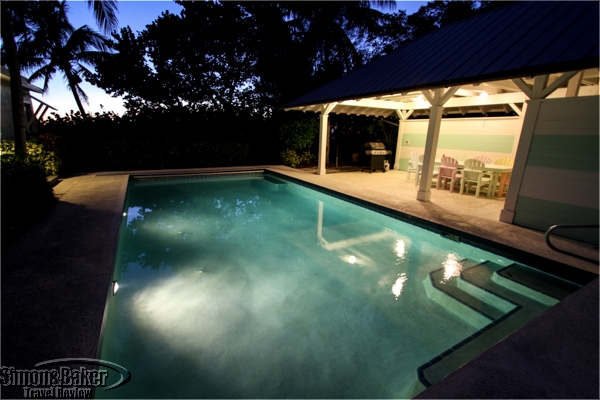
The private pool area was inviting day and night
We liked the quiet, especially indoors, and sense of privacy the home afforded us although it was sandwiched between other houses on two sides and an empty lot adjacent to a busy public beach access with parking. The muted sounds were the result of double-paned windows and a well tended garden with a narrow path that led from the back porch straight to the beach some forty feet away. The distance from the crowded beach and the garden seemed to serve as buffers. We also liked the large private heated swimming pool, an uncommon amenity in rental beachfront houses in town based on an informal tally, and the spacious parking area, which included three spaces under cover.

The bedrooms looked out on the driveway
On the beach, many people walked by at a quick pace. Others set elaborate groupings of chairs and umbrellas, bringing babies, children and dogs (although the beach was supposed to be dog free). Because the water was chilly few went swimming. Once we spent time on the crowded beach we particularly appreciated having private space to ourselves where we could retreat anytime and enjoy beach views in quiet seclusion.

The second bedroom
Although the company website made the rental properties look inviting there were significant errors. When we began our search for a vacation rental we encountered a number of red flags. First, there was limited information on the company website. One property appeared to have never been rented and the second one had had no reviews in more than a year. The most recent review we found said the house needed a facelift. We were unable to find details about the properties, such as terms and conditions, and availability on the rental company website. It also did not indicate when the photos of the house had been taken.

The spacious kitchen also had a beach view
After an initial email reply, the real estate agency woman was slow to respond. When reached on her mobile number she was unable to provide additional information. The first time she answered she explained she was grocery shopping. The next time she said she was visiting her daughter. Then she said she was a realtor and busy selling houses. Unlike every other person we spoke with on the island who answered questions easily and with a pleasant demeanor, her attitude seemed somewhat condescending and dismissive to us. A conversation with a second woman at a United Kingdom location was fruitless.
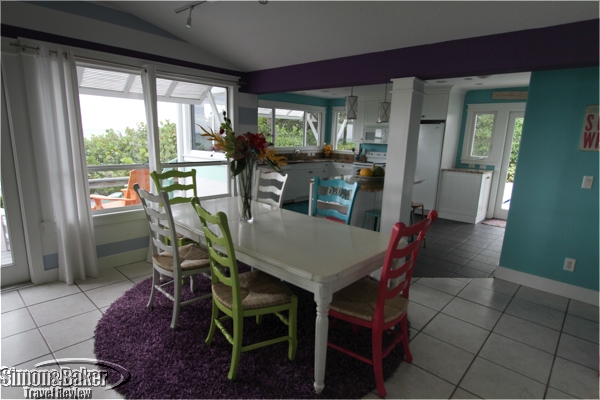
The dining table
After some effort and contradictory information the company representative explained that they had made a mistake listing the first property, the one we preferred. It had a more upscale location and features. After some back and forth communication the representative said the listing with an elaborate video had been in error and the property was not for rent at all. Although it appeared for rent on the company website and was vacant they would not honor the advertised rental. The second property, she prompted, had been renovated and was available at a significant seasonal discount.

The deck and outdoor chairs were in the shade in the mornings.
We swallowed our concerns about the realtor and the property and took the bait. On arrival, the good news was that the property location was excellent. The house fronted the beach and had outstanding views from the back porch, and interior common areas. The pool, on the side of the house, was as we expected. There were however a number of disappointments, mostly the house was in a less than optimum state of repair and the amenities were of a lower quality than we had anticipated for a luxury property. We were surprised to read in the booklet with information on the house that if any equipment broke during our stay there would be no discount, only the agency’s assurance they would try to fix it.
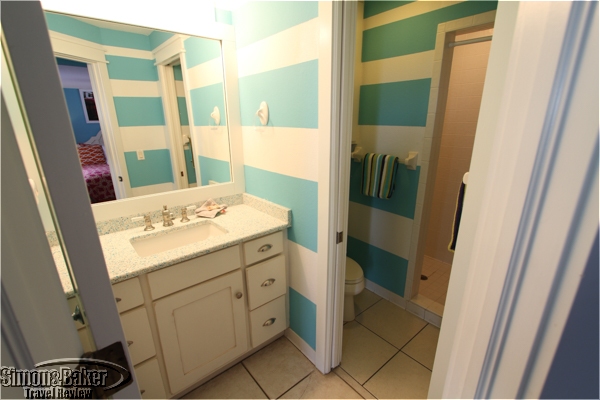
The master bathroom
One of the things we disliked most was the six human hairs strewn in varying places (bed covers, bathroom sink, shower, facecloth, extra blanket) and the smelly mold on the washer door. The towels were mismatched, some stained and very thin. The kitchen towels were synthetic as were the pillows and bed covers. The sheets were of low thread count. The washer soap dispenser was dirty. The dryer didn’t work well at first (we discovered accumulated lint that might have caused the difficulties). The spare blanket smelled strongly of women’s cologne.

Cheerful colors and bright sunlight gave the house a summer feel.
With some effort the repetitive noise of the dining and living room fans subsided. Such was not the case with the loud washer and dryer. The dishwasher door was broken. It had to be latched in place or it would fall open every time we opened it to load or unload items in the appliance.

There were four built-in bunks in the third bedroom.
The colorful outdoor furniture made of synthetic material didn’t overheat, making it possible to sit on the chairs at any time of the day. But because the chairs were in a fixed position they became less than comfortable after a few minutes. There were no cushions on the chairs, which also made then less than ideal for extended lounging. There were only four beach towels for the three bedroom house, which meant if we wanted clean towels after a day at the beach we had to run the noisy washer and dryer.

The sunsets were lovely about half the time.
By the pool there were only two adjustable lounge chairs without cushions or tables (we had to place books and beverages on the floor) and no umbrellas for shade. The lack of umbrellas or cover from the sun made it difficult to enjoy the beach facing porch in the afternoons when sunlight shined directly on that part of the house. No kitchen curtains meant sunlight covered and heated parts of the kitchen (as well as the dining and living areas) during most of the afternoon. The air conditioner and fans struggled to cool the house.

The beach was busy every day.
We enjoyed our time at Limefish as well as our first stay in Holmes Beach and Anna Maria, despite the high density of visitors during our shoulder season visit, and would consider returning. Perhaps by then the property owners and managers will have given the beachfront house some tender loving care or we can find another rental beachfront home.
What we liked about the Sofitel London St James
Article and photos by Scott S. Smith

The Guards’ Crimean War Memorial in front of the Sofitel London St James
In September 2016, my wife, Sandra, and I spent one night at the Sofitel London St James (6 Waterloo Place, London SW1Y 4AN, United Kingdom, +44 0871 6630625 or 800-221-4542, http://www.sofitel.com/gb/hotel-3144-sofitel-london-st-james/index.shtml, H3144@sofitel.com) in central London, United Kingdom. As history buffs, we chose it for its location a few blocks from the Piccadilly Circus subway stop on Waterloo Place, with its magnificent Guards’ Crimean War Memorial.
The memorial was originally erected in 1861 to commemorate 2,152 soldiers who died in the 1854-56 conflict with Russia. Three guards were cast in bronze from captured Russian cannons. The memorial was reconstructed in 1914 to make way for statues of Florence Nightingale and the man who hired her to reform nursing on the front, Secretary of War Sidney Herbert. Nearby is the 34-meter (112 feet) Doric column for Prince Frederick Augustus, the Duke of York, a hero of the British Empire. The area is packed with 150 historic buildings, as well as statues, including those of King Edward VII (eldest son of Queen Victoria and Prince Albert) and Antarctic explorer Robert Falconer. It is also a few blocks from Buckingham Palace and Saint James’s Palace (where retired royal officials now live, and which has its own changing of the guard). A nice touch in the lobby were the gorgeous fresh flower arrangements each day.

Our Premium Luxury Room
Room categories began with the Classic, then Luxury, Superior, Luxury with two single beds, and Premium Luxury. We stayed in a 32 square meters (344 square feet) Premium Luxury Room, one of 183 rooms at the property. We hadn’t realized it was a five-star hotel until we tried the king bed and pillows. They were so well liked by hotel guests (we found them so comfortable we weren’t surprised), that Sofitel sold them in various sizes and styles, from $1,750 to $2,123 at its online shop.
We appreciated the light on the headboard that allowed me to read and not disturb Sandra when she fell asleep early. The view over Waterloo Place and nearby parks was beautiful, but we had to keep the windows shut because of loud exterior noises late at night (we like fresh air, but didn’t mind adjusting the air conditioning instead). The walls, floor, and ceilings were soundproof, so there was no noise from other rooms (a common problem I have encountered at four-star properties). There was an LCD TV, iron and board, safe, Krups coffee-maker, regular brew coffee pot, and complimentary WiFi. There was also complimentary Internet access in the business center. There were two types of complimentary mineral water on the desk. We were surprised by the number of families in the lobby and noted that the hotel offered cribs.

An excellent bathroom
The bathroom had a wonderful rainwater shower and Hermes toiletries. But the things which really distinguished this from other hotels were the deep and long bathtub with easy-to-understand controls (I can rarely find anything that can accommodate my 6’4” frame comfortably), the extensive counter space for both of our personal items, and an outstanding makeup mirror and lighting (even the best hotels usually have inadequate LCD lighting for the mirror).

The Rose Lounge
Breakfast in the restaurant was perhaps the best we’ve ever had in terms of food quality and quantity for people as picky as we are (lacto-ovo vegetarians who prefer whole foods). The sheer number of choices for yogurt and cereal alone were amazing. For example, there were organic and unsweetened selections, including honey and stevia. There were also many choices of cheese for omelets and breads.
After breakfast we visited the Rose Lounge, a lovely area for teas, with a harp in the corner. The staff, each of whom was multilingual, was pleasant. Some were helpful in explaining how to find our way to our daytime destinations. Thanks to its location, friendly service, in room amenities and excellent breakfast the Sofitel London St James would be our number one choice for a future stay in London.
Our lunch at Guy Savoy Paris Latin Quarter restaurant
By Elena del Valle
Photos by Gary Cox

Les Bouquinistes side entrance
In a touristy neighborhood chock full of dining options like the Latin Quarter in Paris, France Les Bouquinistes (53, quai des Grands Augustins, 75006, Paris, France, +33 1 43 25 45 94, www.lesbouquinistes.com, bouquinistes@guysavoy.com) offered several features we liked. Before we arrived it already had the advantage that it was a short walk from our central accommodations. Having dined at Guy Savoy restaurants, including that one, in the past we were confident our experience would be positive. Stéphane Perraud, chef, and Cedric Jossot, restaurant manager, were in charge the day we had lunch at the eatery.

The black and white decor was designed to evoke the printed page
Les Bouquinistes occupied a corner on quai des Grands Augustins on the south side of the Seine River between the Pont Saint-Michel and the Pont Neuf. The two bridges linked the Left Bank with the Ile de la Cite, an island best known for being the home of Notre Dame Cathedral. Large glass windows took maximum advantage of the restaurant’s location facing north toward the busy street, the river and the island beyond it.

The central section of the restaurant featured a wine rack.
Our early arrival won us a choice of seats. We selected a table near the entrance, which afforded us partial views of the street. My lunch partner sat at a leather black bench and I selected an armless wood chair in front of a bare white round table with a round black place mat for each of us. The clean lines, understated décor, gray carpet and black ceiling helped draw our eyes outward beyond the oversize glass walls and windows toward the quai des Grands Augustins to the north and the much quieter rue des Grands Augustins to the east.

A simple yet classic starter
Our multi-course lunch began with a satisfying bite of foie gras atop a thin toast sprinkled with sea salt and touch of black pepper to stimulate our appetite. Our friendly English speaking server brought a wicker basket with crunchy epi bread (no butter or oil) and a bottle of the house sparkling water. Stainless steel cutlery, glassware and dinnerware were the only adornments to our table.

Legumes maraichers a l’oeuf parfait
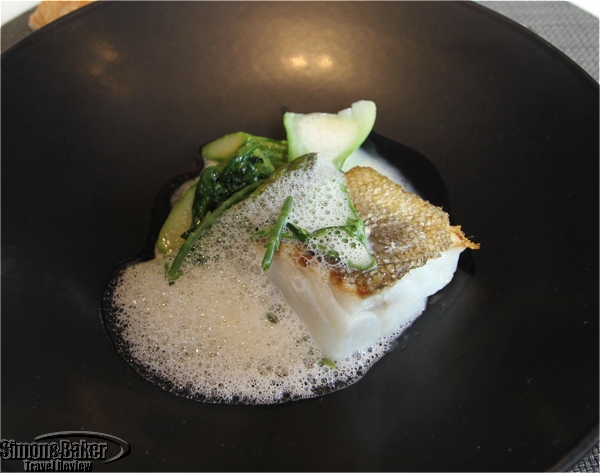
Blanc de cabillaud, asperges et pommes de terres confites, jus aux algues
We each had two different first courses followed by identical mains and desserts, a good sample of the chef’s cuisine. For my first course I had Legumes maraichers a l’oeuf parfait, a vegetable dish with a lightly cooked egg. My lunch mate had Nacre de merlan, vinaigreette d’huitre, petits pois et fromage frais, white fish served on a bed of peas with a cheese and oyster sauce. Blanc de cabillaud, asperges et pommes de terres confites, jus aux algues, beautifully prepared barely cooked codfish served with a wonderful light sauce that complemented the fish and thin crunchy green asparagus; and Homard en bouillon, potimarron et sarrasin torrefie, lobster with sarrazin seed (from Brittany) sauce, pumpkin and black tuile baked wafers colored with squid ink, followed. Noix de carre de veau rotie, oignons grilles, puree de pommes de terre, Veal with a brown sauce, delicate mushrooms, baby onions and mashed potatoes, hit the comfort food funny bone just right. Our server was kind enough to assist us with a selection of Bordeaux wines, including a 2011 Chateaux Dutruch, to match our meal.

Homard en bouillon, potimarron et sarrasin torrefie

Carre de veau rotie, oignons grilles, puree de pommes de terre

Staff members Alexandra Chabauty and Steve Fabre next to Stéphane Perraud, chef, and Cédric Jossot, restaurant manager
Dessert was a duo. One half was Cafe-chocolat lacte biskelia-cardamone blanche, a mix of coffee flavored bits, and the other was a Sable breton-menthe-coriandre, a “Gin and Tonic” mint coriander dish served with a cookie and a microwave sponge cake. By the time we left, the restaurant was at the peak of lunch hour and staff members were rushing to look after last minute arrivals. Our meal was satisfying, well served and in an attractive setting within a convenient location. We would return and recommend it to friends seeking a casual dining experience in the Latin Quarter within a stone’s throw of the river.
Dinner at Black Forest Highlands gourmet restaurant
By Elena del Valle
Photos by Gary Cox

While at the Hotel Adler we had our only sunny afternoon in the Black Forest
During a trip to the Black Forest Highlands of southwestern Germany, we stayed at the Hotel Adler and had dinner at the hotel’s Restaurant Adler (Hotel Adler, St. Fridolinstrasse 15, 79837 Häusern, Germany, +49 7672 4170, fax +49 7672 417150, www.adler-schwarzwald.de, info@adler-schwarzwald.de). We liked the well presented and colorful regional food with international influences and wine pairings prepared by Florian Zumkeller, the restaurant’s chef, owner and manager.

Our table was in a cozy corner with padded bench seats
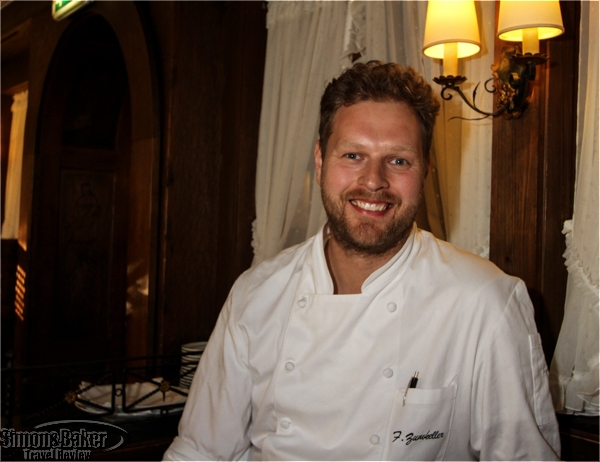
Florian Zumkeller, the restaurant’s chef, owner and manager
The Black Forest fine dining venue had red tile flooring, cushioned wood bench seats, a low wood ceiling and regional décor, including a large crucifix across from our table. Salient features were tablecloths and silverware as well as glassware from Schott Zwiesel and tableware from Rosenthal. The restaurant was 250 square meters in size with a staff of 12 and capable of accommodating 80 guests. Nishan, our Sri Lankan English speaking server, was friendly and attentive.

The colorful mackerel sashimi

My asparagus dish
There were three types of bread on offer: onion, seeded, and baguette. Four types of butter: herb, red onion, salted and unsalted were presented on a black ceramic plate with a small fork and a spoon. The appetite teaser was a slightly sweet mackerel sashimi with an exotic flavor. To start the meal there was a veal sweetbreads appetizer with bitter salad and lemon vinaigrette (a favorite) served with 2015 Weinhaus Joachim Heger Grau Weissburgunder Cuvee. I selected an asparagus dish instead. Next there was Lobster with nectarine and pancetta served with 2014 Scherzinger Batzenberg Chardonnay Alte Reben Weingut Heinemann, Scherzinger.

The veal sweetbreads appetizer with bitter salad and lemon vinaigrette was a favorite

The main course was Two variations of United States beef with celery, mushroom and hazelnut
Two variations of United States beef with celery, mushroom and hazelnut, a medium rare tasty meat course, followed. We appreciated that the beef was antibiotic and hormone free. It was served with 2014 Cabernet Cuvee from Weinhaus Joachim Heger. For dessert there was Frozen tiramisu with peach and raspberry served with 2014 Durbacher Plauelrain, Traminer Auslese, Weingut Laible. After dessert there were chocolate praline balls served with Amaretto cream with almonds.

Nishan, our Sri Lankan English speaking server, was friendly and attentive
Chef Zumkeller did an apprenticeship with Alfred Klink at the Colombi Hotel in Freiburg, Germany. Before taking the reigns of the Restaurant Adler in 2011, he worked with chefs Philippe Chevrier at Domaine de Châteauvieux and Adolfo Blokbergen at L’Auberge du Raisin.

Lobster with nectarine and pancetta

Frozen tiramisu with peach and raspberry
He proudly explained, when we met him at the conclusion of our meal, that for 50 continuous years, since 1966, the restaurant had received a Michelin Star. Should we be in Hausern again, the restaurant’s gourmet dinner with a touch of innovation and good service in a traditional Black Forest dining room would tempt us to return.
RFID blocking Neck Stash performed well on Europe trip
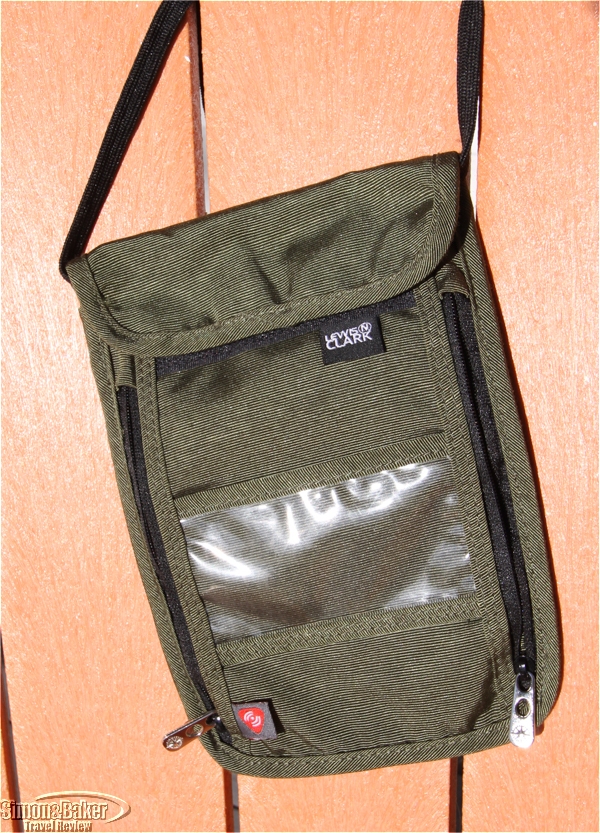
The RFID-Blocking Luxe Neck Stash in Olive from Lewis N. Clark
On a trip to Europe this spring our contributors took a $22.49 RFID-Blocking Luxe Neck Stash in Olive from Lewis N. Clark (owned by LCI Brands, 2781 Katherine Way, Elk Grove Village, Illinois 60007, +1 312.455.0500, www.lewisnclark.com, info@lcibrands.com). The slim made in China nylon neck bag, 8 inches by 5.5 inches, performed well and only weighed 5.5 ounces. It hung from a thin adjustable neck cord and could be tucked beneath clothes to conceal it.
While they did not require Radio Frequency Identification (RFID) blocking for credit cards and passports it was good to know the Neck Stash had it should the need arise. Pluses included the discreet olive color and size as well as its single see-through window and dual zippered pockets. A central Velcro flap pocket that opened at the top was ideal for passports. The neck bag was convenient to carry important documents and cash around cities, and for easy document access at airports and while traveling. The durable, ribbed TravelDry fabric was designed to resist shrinking, odors, and mildew. It showed no signs of wear after six weeks.


